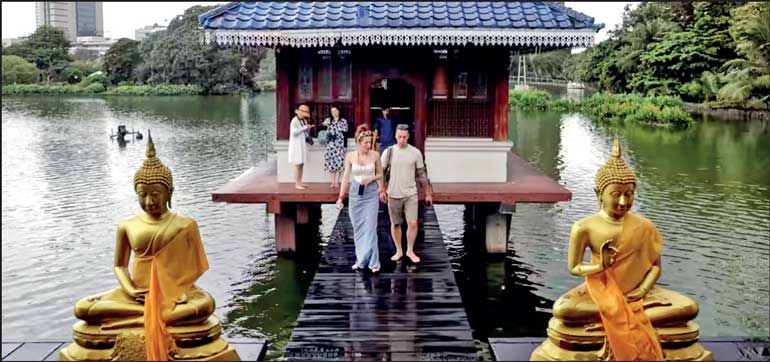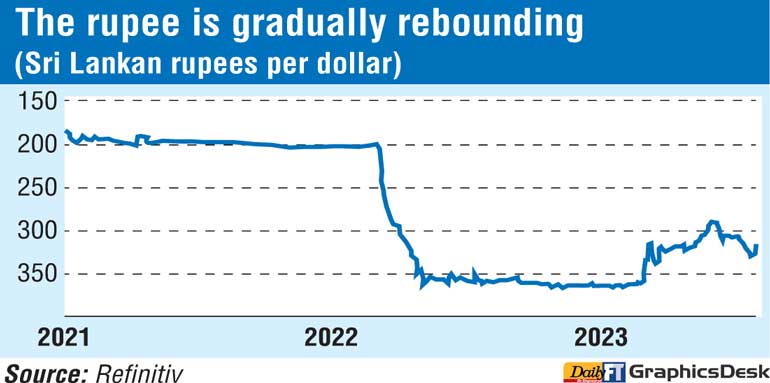Wednesday Apr 16, 2025
Wednesday Apr 16, 2025
Friday, 4 August 2023 00:18 - - {{hitsCtrl.values.hits}}

Tourists at Gangaramaya Temple in Colombo in July: The tourism rebound will be key to rebuilding Sri Lanka’s foreign reserves - Reuters

By Ruchir Desai
asia.nikkei.com: Rising interest rates and falling export demand are blunting the post-COVID economic resurgence of many Asian economies.
But for Sri Lanka, the only country in the region to default on its official debt amid the economic squeeze caused by the pandemic and the Ukraine war, these are sunny days.
Tourism revenue and remittances from Sri Lankan workers overseas have come roaring back. Inflation, which reached 70% last September, was back down to 6.3% in July. As a result, the Central Bank of Sri Lanka has cut its benchmark interest rate by 4.5 percentage points since June.
Last year’s default was the result of a confluence of factors depleting Sri Lanka’s foreign exchange reserves.
Receipts from tourism, an industry that previously brought in close to $ 5 billion a year in foreign exchange earnings, plunged after the 2019 Easter Sunday bombings of three churches and three luxury hotels; visitors did not return amid COVID-19. Heavy external borrowings, populist moves to cut taxes and political infighting took their toll on investor confidence and the country’s macroeconomic position.
The outbreak of the Ukraine war last year then delivered an unbearable blow. With foreign reserves running low, the country had to deal with soaring costs for imported food and fuel. The Government could not turn to international capital markets to shore up its reserves given the lack of confidence in its ability to repay in addition to rising global interest rates.
The Central Bank of Sri Lanka was forced to print money to finance the Government’s deficit. This led to a collapse in the value of the Sri Lankan rupee, accelerating inflation. With the Government unable to provide or pay for the daily necessities and prices skyrocketing, it was little surprise that popular sentiment against the Government boiled over and then-President Gotabaya Rajapaksa was forced to flee the country in July 2022.
Ranil Wickremesinghe, his successor, quickly took measures to stabilise the situation by opening talks with the International Monetary Fund on a loan and getting interim support from regional neighbours like India.
To win the IMF’s support, Colombo took hard but much-needed steps to increase fuel and electricity prices as well as raise tax rates and extend the tax net. A new Central Bank Governor raised benchmark interest rates by 8 percentage points over the course of 2022 to try to put a lid on inflation and bring a degree of macroeconomic stability.
When I visited Sri Lanka in November, the situation on the ground remained tough, with high inflation and interest rates keeping a lid on corporate and consumer sentiment. However, it was also quite clear that both had peaked and that the economic cycle had begun to turn as a result of the hard decisions made over the previous few months.
When I returned in June, there were clear signs of change. Both my flight in and hotel were full, even though it was the low season for visitors.
In the first half of the year, tourism revenues reached almost $ 1 billion while inbound remittances reached $ 3 billion. Both are expected to at least match these performances in the second half of the year.
Though that would still be below pre-COVID levels, the country can easily get back to its previous level of $ 4.4 billion in tourism receipts and $ 7 billion in worker remittances. This would go a long way toward helping Sri Lanka manage its current-account deficit and add to macroeconomic stability and growth. Companies, meanwhile, are benefiting from greater dollar availability and stable power supplies.
The IMF, which approved support for Colombo in March, estimates Sri Lanka’s current-account deficit will be around 1.5% of gross domestic product from this year onward. This would be a manageable and normal level for any developing country that is a net importer of fuel and food.
A Government domestic debt restructuring program has removed a lot of uncertainty, especially within the Sri Lankan banking sector. Colombo is in discussions with external creditors on restructuring the country’s external debt. The Government also continues to follow through on its reform program by initiating the privatisation of State-owned assets like SriLankan Airlines and Sri Lanka Telecom.
The rupee and the country’s stock market have reacted positively to recent macroeconomic developments; both have been among the world’s best performers so far this year.
The decline in inflation and interest rates, the rebound in tourism and the commitment of the Government to reform bode well for Sri Lanka’s outlook. In the near term, as inflation comes down further, I would not be surprised to see benchmark interest rates come down another 3 or 4 percentage points. This would further bolster the economic recovery and investor sentiment.
In the medium to long term, Sri Lanka must fully leverage its excellent geographic location to further build up its tourism and logistics industries. These can help the country to significantly increase its foreign exchange reserves. Policymakers should not miss the boat on this and fully support both industries by executing policies aimed at improving tourism and logistics infrastructure like airport and port facilities.
Execution has not been the strongest area for Sri Lankan policymakers. But with the support of the IMF, neighbouring countries and investors, Sri Lanka cannot ask for a better platform to generate sustainable and all-around economic growth. (Source: https://asia.nikkei.com/Opinion/Sri-Lanka-is-back-in-business).
(The writer is the co-fund manager of Asia Frontier Capital’s AFC Asia Frontier Fund)